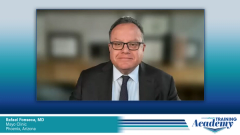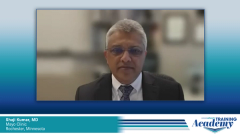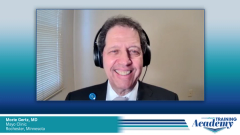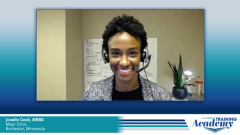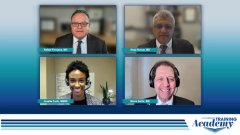
Insights from Experts at Mayo Clinic: Sequencing Therapies in MM
Comprehensive insights from experts in Mayo Clinic on the selection and sequencing of CAR T cell therapy or bispecifics, respectively, in patients with relapsed/refractory multiple myeloma.
Episodes in this series

Transcript:
Rafael Fonseca, MD: Let me ask Dr Cook. When you think about teclistamab, now that we have it as a commercially available product, how are you using it in your clinical practice? And if you don’t mind just speculating a little bit, where do you see it playing a role in the overall treatment landscape?
Joselle Cook, MBBS: That’s a really good question. I think that’s like the million-dollar question. Honestly, I’ve been retrieving patients’ T cells for CAR [chimeric antigen receptor] T-cell therapy first, and then preferentially using a bispecific afterwards. The reason is there’s this eternal question about possible T-cell exhaustion by persistent antigen stimulation or tonic receptor signaling. And so, for that reason, in my practice, I would do the T-cell apheresis first and do CAR T in patients who are fit and who can proceed with CAR T, and then allow those patients a treatment-free interval, then potentially use a bispecific afterwards at the time of relapse. I think we’re going to have to see how the bispecifics play when we think about how we are going to sequence these agents, because there are so many that we’re potentially looking at using. We have BCMA [B-cell maturation antigen] bispecific, we have BCMA CAR-T products, but then we’re also talking about the FcRH5B [Fc receptor-homolog 5] bispecific and GPRC5D [G protein-coupled receptor, family C, group 5, member D]. I’m interested to see how we’re going to sequence all of those products, but right now my preference would be BCMA CAR T first, and then BCMA BiTE [bispecific T cell engager] afterwards.
Rafael Fonseca, MD: Thank you. I know that’s an ongoing debate, right? How do we sequence these agents? And I think it’s fair to say, I’ve heard more opinions for going with CAR T-cell therapy first, and then a bispecific. On the other hand, personally for me, 1 of my hopes is that because of how bispecifics can be used, particularly in community hospitals, many more multiple myeloma patients can ultimately be treated with a therapy like this. Dr Gertz, what are your thoughts about where we are and where we are going?
Morie Gertz, MD: Right. I think this preference for CAR T is more experiential. We’ve been using it for 5 years and bispecifics we’ve been using for 18 months. I think as experience grows, it’s going to shift. I think that CAR T, with the issues of bridging chemotherapy and lymphodepleting chemotherapy to finally get to the product, doesn’t really realize the full potential of immunotherapy. I think having something that you can take off-the-shelf, see a patient and say “I’m going to start you on this next week” is going to be a big deal. But we’re really still in the fog because, in talking with community physicians, there are a lot of barriers. If you look at least on the labeling for administration of bispecifics, you’re supposed to start it in the hospital. For people who are on fixed reimbursement in a DRG [diagnosis related group], the cost of the drug is more than the DRG. So, their own hospitals and their own hospital pharmacies won’t allow them to give the drug in an outpatient setting. As you’re going to hear, Mayo Clinic’s unique infrastructure allows us to not follow the FDA [US Food and Drug Administration] guidelines of inpatient administration. So, what doctors in the community have been asking me is “Can I give the first 2 to 3 doses at Mayo Clinic? And once we’re through cytopenias and cytokine release syndrome, then I can see the patient for outpatient management.” That’s something that they’re very, very interested in. There are other issues with requirements for when you give these immune therapies. It’s required by guidelines that you have 2 doses of tocilizumab in the pharmacy, and in some community hospitals just the cost of 2 doses of tocilizumab in the pharmacy gets crazy. In some smaller cities, the hospitals are networking so that a central pharmacy supply has the 2 doses of tocilizumab immediately available for distribution. You see all these issues we’re having to work through. It’s going to take us a year to a year and a half before we’re saying it’s off-the-shelf and you can just give it, and the patients won’t have to spend the month at a major medical center. But I honestly think that from the patient standpoint, “I don’t have to relocate.” And from a practicing oncologist standpoint, I think that bispecifics will supplant CAR T. It’s just that we have more familiarity with CAR T.
Rafael Fonseca, MD: So many great comments, and I agree with you on the practicalities. I’m going to say it’s probably more than a year and a half. I love the story about this coordination, this network to have some of the supportive drugs, like tocilizumab, available. Shaji, I know I’m going to ask you about the step-up dosing at Mayo Clinic, but before I do that, let me ask you a general question, too. I know you’ve written a lot about the survival of patients with penta-refractory multiple myeloma and exposed patients, which is really not that good. And we see these trials and we see a significant improvement in the lives of patients, right? On the other hand, I hold this axiomatic belief that it’s better to use the best drugs up front because of attrition and all those things. You saw the data that our colleague Mark Litzow, MD, presented for ALL [acute lymphoblastic leukemia] at the last ASH [American Society of Hematology] meeting, right? Late-breaking abstract. Even in MRD [measurable residual disease] negative, blinatumomab is producing a big difference. So, what is your prediction? Are bispecifics going to stay in this phase, or—and it’s a prediction only because we know there are no trials—are they going to move up front? What are your thoughts?
Shaji Kumar, MD: Yeah, I think my prediction would be that the bispecifics will move up front. I think 1 thing we have learned in multiple myeloma is that just going after the tumor with 1 drug is probably not going to be the best approach, and we need to have combinations. I think bispecifics are uniquely placed to be able to be combined with other therapies. I know we’ll be talking about the daratumumab combination later, but there are ongoing trials trying to incorporate the bispecific antibodies into that up-front setting, along with the drugs we are currently using. I suspect, again, because of the discussion we had before in terms of the applicability and where we can give it, a combination that includes a bispecific is something that would be widely applicable. Patients everywhere can get it. So, I suspect it’s going to be an integral component of that initial therapy. Now, if that is the case, then where does CAR T-cell therapy fall? It’s hard to know. I think 1 of the advantages of the CAR T cells that we had talked about is it’s once and done, but what we have learned so far is it’s probably not once and done because the majority of the patients relapse. I suspect there’s a significant proportion of patients who will need some kind of maintenance after CAR T, which will take away that potential advantage. So, I think there’s probably going to be a bispecific antibody-based combination or included combination that is given for a specific or a defined period of time in the newly diagnosed setting, with a subset of patients proceeding to CAR T, or transplant, or both.
Joselle Cook, MBBS: I think that brings up a really interesting point, as well. If CAR T remains part of the treatment landscape and we move the bispecifics earlier and earlier, when would we collect the CAR T cells? Just like we collect stem cells early for transplant, do we collect T cells at the same time? Just something to think about, how we plan for the future.
Rafael Fonseca, MD: You’re absolutely right, Dr Cook. And people have said, obviously in the setting of lymphoma and leukemia, you collect T cells earlier on. But T cells that are being collected in multiple myeloma have been through a lot. They have a lot of mileage with multiple therapies. So, it’s not unreasonable to think that they might not be as fit. And we can talk more about that, as well. It turns out, and maybe I’m jumping 2 steps ahead, but we’re also collecting stem cells just because of the cytopenias that we see, right? So, I think we’re going to have questions for many, many years going forward.
Transcript edited for clarity.
Newsletter
Stay up to date on recent advances in the multidisciplinary approach to cancer.


